What's What in the Painting: A Visual Glossary
The painting Seven Miles to Farmington is filled with buildings, objects, and people. Use this resource to learn the name and function of the elements featured in the painting. Click on the dot nearest the object to see the information. Many will have a “More…” button to reveal other versions of a particular object also painted by George Durrie.
Wagon
Wagons were used to carry large or heavy loads around the farm. They were pulled by oxen or horses. This wagon has four wooden wheels (two in front and two slightly larger ones in the back. Wagons with wheels were less useful in the snow, however.
George H. Durrie (1820-1863) Detail of Seven Miles to Farmington, ca. 1853
Oil on canvas, 26 x 36 1/8 inches. Florence Griswold Museum, Gift of The Hartford Steam Boiler Inspection and Insurance Company
More Wagons by Durrie Back to Top Ladder
Made of wood, this ladder would be useful for chores that required climbing. Durrie often includes ladders, poles, and sticks to give his paintings visual interest.
George H. Durrie (1820-1863) Detail of Seven Miles to Farmington, ca. 1853
Oil on canvas, 26 x 36 1/8 inches. Florence Griswold Museum, Gift of The Hartford Steam Boiler Inspection and Insurance Company
Back to Top Wagon Wheel
This wooden wagon wheel might be a spare for the wagon in the yard or from another wagon out of sight.
George H. Durrie (1820-1863) Detail of Seven Miles to Farmington, ca. 1853
Oil on canvas, 26 x 36 1/8 inches. Florence Griswold Museum, Gift of The Hartford Steam Boiler Inspection and Insurance Company
More Wagons by Durrie Back to Top Stable
The smaller wood structure attached to the barn is used to house livestock such as the oxen.
George H. Durrie (1820-1863) Detail of Seven Miles to Farmington, ca. 1853
Oil on canvas, 26 x 36 1/8 inches. Florence Griswold Museum, Gift of The Hartford Steam Boiler Inspection and Insurance Company
More Stables by Durrie Back to Top Oxen
This pair of ox, or oxen, are used on the farm to pull farm equipment such as wagons, plows, harrows. Oxen are male cows. These have short pointy horns on their heads.
George H. Durrie (1820-1863) Detail of Seven Miles to Farmington, ca. 1853
Oil on canvas, 26 x 36 1/8 inches. Florence Griswold Museum, Gift of The Hartford Steam Boiler Inspection and Insurance Company
More Oxen by Durrie Back to Top Tree (Leafless)
The large tree is different from the one on the far right as it has lost all of its leaves for the winter. Its placement on the left and its slight lean to the right allow it to frame the view towards the inn. At its base, the ground appears to give way to a small body of water that has exposed some of its roots. There is light snow on top of some of the branches as well as gathered in the notches of the tree. Very similar trees appear behind the barn and house.
George H. Durrie (1820-1863) Detail of Seven Miles to Farmington, ca. 1853
Oil on canvas, 26 x 36 1/8 inches. Florence Griswold Museum, Gift of The Hartford Steam Boiler Inspection and Insurance Company
More Trees by Durrie Back to Top Harrow
This A-frame harrow (shaped like an A) was pulled by an ox or horse across a farmer’s field. The stubby wood pegs would break up clumps of dirt and smooth the ground after it was plowed. The triangular A-shape was less likely to get caught on stumps or rocks.
George H. Durrie (1820-1863) Detail of Seven Miles to Farmington, ca. 1853
Oil on canvas, 26 x 36 1/8 inches. Florence Griswold Museum, Gift of The Hartford Steam Boiler Inspection and Insurance Company
Back to Top Barn
The large wooden building is an English-style barn, popular in New England. Barns like this had a center aisle with pens for livestock on one side and areas for storage on the other. The large barn doors on the front are swung open as is the smaller door in the far corner.
George H. Durrie (1820-1863) Detail of Seven Miles to Farmington, ca. 1853
Oil on canvas, 26 x 36 1/8 inches. Florence Griswold Museum, Gift of The Hartford Steam Boiler Inspection and Insurance Company
More Barns by Durrie Back to Top Pitch Fork
Farm tool used to lift and “pitch” or throw loose material such as hay, straw, or leaves. This pitch fork has two metal tines, or prongs, attached to a wooden handle.
George H. Durrie (1820-1863) Detail of Seven Miles to Farmington, ca. 1853
Oil on canvas, 26 x 36 1/8 inches. Florence Griswold Museum, Gift of The Hartford Steam Boiler Inspection and Insurance Company
Back to Top Man in dark brown jacket, tan pants, knit cap
A male African-American worker who likely helped take care of the animals or clean the sheds. He appears to be carrying something from the barns to the house. Slavery had been abolished at this point in Connecticut history, so we know he is not a slave. He appears to be young and probably does not get paid well for his work. He is dressed in a dark brown jacket or short coat and dark tan trousers. He is keeping out the cold with this purple knitted cap.
George H. Durrie (1820-1863) Detail of Seven Miles to Farmington, ca. 1853
Oil on canvas, 26 x 36 1/8 inches. Florence Griswold Museum, Gift of The Hartford Steam Boiler Inspection and Insurance Company
Back to Top Wagon Shed
This long wooden structure is open on one side to provide easy access for wagons, carts, or sleighs.
George H. Durrie (1820-1863) Detail of Seven Miles to Farmington, ca. 1853
Oil on canvas, 26 x 36 1/8 inches. Florence Griswold Museum, Gift of The Hartford Steam Boiler Inspection and Insurance Company
Back to Top Two men talking near wagon shed, one with a top hat, the other with a wide-brimmed hat
These two men are conversing, possibly about business of some sort. One might be connected to the inn working at the livery stable manager. Such a livery stable is a place where privately owned horses can be boarded (rested, fed, and watered) for a short time, often connected to an inn. The other might be making arrangements for his horse. Both are wearing long over coats and large hats, as was typical for that time period and season.
George H. Durrie (1820-1863) Detail of Seven Miles to Farmington, ca. 1853
Oil on canvas, 26 x 36 1/8 inches. Florence Griswold Museum, Gift of The Hartford Steam Boiler Inspection and Insurance Company
Back to Top Horse (White)
This horse is ready for a rider. It has a leather saddle on its back and a bridle in its mouth. The reins are tied to the hitching post.
George H. Durrie (1820-1863) Detail of Seven Miles to Farmington, ca. 1853
Oil on canvas, 26 x 36 1/8 inches. Florence Griswold Museum, Gift of The Hartford Steam Boiler Inspection and Insurance Company
More Horses by Durrie Back to Top Dogs
The dogs appear to be two Foxhounds, used to hunt foxes. They have a musical bark and excellent sense of smell.
George H. Durrie (1820-1863) Detail of Seven Miles to Farmington, ca. 1853
Oil on canvas, 26 x 36 1/8 inches. Florence Griswold Museum, Gift of The Hartford Steam Boiler Inspection and Insurance Company
More Dogs by Durrie Back to Top Boulders
Connecticut farmers have long been aware of the state’s rocky soil. These boulders are similar to the rocks farmers would clear from their field and stack into walls. Smaller rocks, cobbled round by glacier activity would be used for more detailed work stone work, such as the chimney stacks.
George H. Durrie (1820-1863) Detail of Seven Miles to Farmington, ca. 1853
Oil on canvas, 26 x 36 1/8 inches. Florence Griswold Museum, Gift of The Hartford Steam Boiler Inspection and Insurance Company
More Boulders by Durrie Back to Top Saltbox
This type of house has two stories in front and one story in the rear giving it a distinctive asymmetrical profile. The name comes from actual salt boxes used to store salt for cooking. The boxes often had sloped lids and hung near fireplaces to keep the salt dry. The style of house was popular between 1680s and 1830s. This saltbox has dual stone chimneys (less common than a single center chimney). It’s difficult to determine if the one side of the house is unpainted or in dark shadow.
George H. Durrie (1820-1863) Detail of Seven Miles to Farmington, ca. 1853
Oil on canvas, 26 x 36 1/8 inches. Florence Griswold Museum, Gift of The Hartford Steam Boiler Inspection and Insurance Company
More Saltboxes by Durrie Back to Top Covered Porch
The house has a covered porch across the front of the house. The long bench on the left side suggests the porch as a place for gathering and waiting. There are four shuttered windows at the rear of the porch and a doorway in the center.
George H. Durrie (1820-1863) Detail of Seven Miles to Farmington, ca. 1853
Oil on canvas, 26 x 36 1/8 inches. Florence Griswold Museum, Gift of The Hartford Steam Boiler Inspection and Insurance Company
Back to Top Windows with Green Shutters
The windows are most likely the double-hung variety with 12 panes of glass in both the upper and lower sash. The upper sash was fixed but the bottom one could be slid upwards. The panes of glass were standard sizes measuring 6 x 8 inches. The shutters were on hinges and could be closed, or shut, to protect the glass from the elements.
George H. Durrie (1820-1863) Detail of Seven Miles to Farmington, ca. 1853
Oil on canvas, 26 x 36 1/8 inches. Florence Griswold Museum, Gift of The Hartford Steam Boiler Inspection and Insurance Company
Back to Top Bucket
The large wooden bucket is held together with metal bands and painted green. It may be for offering water or grain to the many horses arriving at the inn.
George H. Durrie (1820-1863) Detail of Seven Miles to Farmington, ca. 1853
Oil on canvas, 26 x 36 1/8 inches. Florence Griswold Museum, Gift of The Hartford Steam Boiler Inspection and Insurance Company
Back to Top Horse (Dark Brown)
This horse is harnessed to pull the green sled. There is a ring of bells around its neck that would jingle as it moves to warn other travelers of its arrival. This would be most helpful after dark.
George H. Durrie (1820-1863) Detail of Seven Miles to Farmington, ca. 1853
Oil on canvas, 26 x 36 1/8 inches. Florence Griswold Museum, Gift of The Hartford Steam Boiler Inspection and Insurance Company
More Horses by Durrie Back to Top Open Sleigh (Green and Yellow Flat Bed)
George H. Durrie (1820-1863) Detail of Seven Miles to Farmington, ca. 1853
Oil on canvas, 26 x 36 1/8 inches. Florence Griswold Museum, Gift of The Hartford Steam Boiler Inspection and Insurance Company
More Sleighs by Durrie Back to Top Man in tan coat with reddish brown hat
This man is dressed for the cold weather wearing what appears to be a large oversmock or coat. He could possibly be another stableman, in charge of taking care of the animals around the inn. He could even be a groom to one of the women arriving in the sled, anticipating her arrival and waiting outside the door of the inn with excitement.
George H. Durrie (1820-1863) Detail of Seven Miles to Farmington, ca. 1853
Oil on canvas, 26 x 36 1/8 inches. Florence Griswold Museum, Gift of The Hartford Steam Boiler Inspection and Insurance Company
Back to Top Man with black top hat wearing a light brown overcoat
Also sporting a long overcoat and top hat, this man appears to be a common traveler, typical of the sort that would visit this inn, especially in the winter weather. Travel was not nearly as easy as it is now, and trains were just starting to become widespread and popular. Canals, while present, did not connect all of Connecticut, and so were not always an option. Inns made life for travelers much easier, so that if weather was bad or the journey was long, one could just stay at an inn to rest up for the next day.
George H. Durrie (1820-1863) Detail of Seven Miles to Farmington, ca. 1853
Oil on canvas, 26 x 36 1/8 inches. Florence Griswold Museum, Gift of The Hartford Steam Boiler Inspection and Insurance Company
Back to Top Man in black top hat and overcoat with woman in brown cloak and yellow bonnet
A male traveler that appears to be conversing with a female traveler that may have come from the nearby sleigh. It appears that he is either welcoming her or wishing her goodbye. Perhaps the man is affiliated with the inn and she is inquiring as to the cost of staying there. They are both well prepared for the cold, with the man sporting his long overcoat and top hat, and the women wearing her bonnet and cloak, typical attire of the time, with her arms seemingly wrapped around herself.
George H. Durrie (1820-1863) Detail of Seven Miles to Farmington, ca. 1853
Oil on canvas, 26 x 36 1/8 inches. Florence Griswold Museum, Gift of The Hartford Steam Boiler Inspection and Insurance Company
Back to Top White-clad woman alone in sleigh
A female traveler who is likely just arriving. Her face is visible, and almost seems anxious, as if she is waiting or expecting someone. She appears to be looking out across the yard, perhaps seeing or anticipating who will arrive in the sleighs.
George H. Durrie (1820-1863) Detail of Seven Miles to Farmington, ca. 1853
Oil on canvas, 26 x 36 1/8 inches. Florence Griswold Museum, Gift of The Hartford Steam Boiler Inspection and Insurance Company
Back to Top Inn Sign on Tall Pole
Although illegible, the oval sign hanging from the tall wooden pole, advertises that this yellow house is a public inn. There is also a birdhouse above the sign. The combination of sign and pole would be enough to let a traveler know this was a place they could stay for the night.
George H. Durrie (1820-1863) Detail of Seven Miles to Farmington, ca. 1853
Oil on canvas, 26 x 36 1/8 inches. Florence Griswold Museum, Gift of The Hartford Steam Boiler Inspection and Insurance Company
More Inn Signs by Durrie Back to Top Birdhouse
The small structure with five openings is used to house birds. The five openings echo the number of windows of the house.
George H. Durrie (1820-1863) Detail of Seven Miles to Farmington, ca. 1853
Oil on canvas, 26 x 36 1/8 inches. Florence Griswold Museum, Gift of The Hartford Steam Boiler Inspection and Insurance Company
Back to Top Grey Horse with Sleigh Bells
George H. Durrie (1820-1863) Detail of Seven Miles to Farmington, ca. 1853
Oil on canvas, 26 x 36 1/8 inches. Florence Griswold Museum, Gift of The Hartford Steam Boiler Inspection and Insurance Company
More Horses by Durrie Back to Top Open Sleigh (Yellow Body and Yellow Runners)
George H. Durrie (1820-1863) Detail of Seven Miles to Farmington, ca. 1853
Oil on canvas, 26 x 36 1/8 inches. Florence Griswold Museum, Gift of The Hartford Steam Boiler Inspection and Insurance Company
More Sleighs by Durrie Back to Top Man in sled wearing a green overcoat and hat
This man is a sled driver who appears to be delivering goods. He seems to be delivering grain that is packaged in canvas bags. This man could be bringing the items to the inn, or he could be stopping at the inn for the night so that he can continue their journey the next day. The grain could be used to cook, but could also be important food for the animals, especially during the winter months when grass is not readily available for animals to pasture.
George H. Durrie (1820-1863) Detail of Seven Miles to Farmington, ca. 1853
Oil on canvas, 26 x 36 1/8 inches. Florence Griswold Museum, Gift of The Hartford Steam Boiler Inspection and Insurance Company
Back to Top Standing man in sleigh with red neckwear
This man is a sleigh driver, and is likely standing in order to slow his horse to down to a stop. Unlike Figure 9, this man is not delivering goods, but he is transporting people. Highways were developed in Connecticut at this point, and if you were traveling locally, wagon was your best option when it was not snowy, and sleighs worked well in the winter weather. Since it was winter time, to see sleigh driver’s such as this man was common.
George H. Durrie (1820-1863) Detail of Seven Miles to Farmington, ca. 1853
Oil on canvas, 26 x 36 1/8 inches. Florence Griswold Museum, Gift of The Hartford Steam Boiler Inspection and Insurance Company
Back to Top Light Brown Horse
George H. Durrie (1820-1863) Detail of Seven Miles to Farmington, ca. 1853
Oil on canvas, 26 x 36 1/8 inches. Florence Griswold Museum, Gift of The Hartford Steam Boiler Inspection and Insurance Company
More Horses by Durrie Back to Top Open Sleigh (Reddish Body and Yellow Runners)
George H. Durrie (1820-1863) Detail of Seven Miles to Farmington, ca. 1853
Oil on canvas, 26 x 36 1/8 inches. Florence Griswold Museum, Gift of The Hartford Steam Boiler Inspection and Insurance Company
More Sleighs by Durrie Back to Top Women in the sleigh wearing red and blue bonnets
These two women are sleigh passengers and appear to be in deep discussion, facing each other. As the horse appears to be slowing down, it seems that they are going to stay at the inn for a period of time.
George H. Durrie (1820-1863) Detail of Seven Miles to Farmington, ca. 1853
Oil on canvas, 26 x 36 1/8 inches. Florence Griswold Museum, Gift of The Hartford Steam Boiler Inspection and Insurance Company
Back to Top Four people in a sled with two man in the front and two women in the back
Four people in a sled with two man in the front and two women in the back The two men are a sled driver and passenger. While the sleigh driver (tan overcoat) is focusing on the horse, the passenger appears to be fraternizing with the two women in the back of the sled and could be acquaintances with them. The two women seem to be actively engaged in the conversation. It is also possible that everyone traveling in the sleigh is a family.
George H. Durrie (1820-1863) Detail of Seven Miles to Farmington, ca. 1853
Oil on canvas, 26 x 36 1/8 inches. Florence Griswold Museum, Gift of The Hartford Steam Boiler Inspection and Insurance Company
Back to Top Fence Post with Broken Rail
The upright post is granite, a quarried stone widely available in Connecticut, shaped into a crude point with a hole to hold the wood rail. This appears to be all that is left of a fence or gateway at the entrance to the farmstead.
George H. Durrie (1820-1863) Detail of Seven Miles to Farmington, ca. 1853
Oil on canvas, 26 x 36 1/8 inches. Florence Griswold Museum, Gift of The Hartford Steam Boiler Inspection and Insurance Company
More Granite Posts by Durrie Back to Top Dark Brown Horse
George H. Durrie (1820-1863) Detail of Seven Miles to Farmington, ca. 1853
Oil on canvas, 26 x 36 1/8 inches. Florence Griswold Museum, Gift of The Hartford Steam Boiler Inspection and Insurance Company
More Horses by Durrie Back to Top Open Sleigh (Red)
George H. Durrie (1820-1863) Detail of Seven Miles to Farmington, ca. 1853
Oil on canvas, 26 x 36 1/8 inches. Florence Griswold Museum, Gift of The Hartford Steam Boiler Inspection and Insurance Company
More Sleighs by Durrie Back to Top Sacks
The red sleigh is filled with at least three large beige-colored sacks (possibly burlap) and may be filled with flour fresh from the mill. The artist painted other images of grist mills with sleighs departing full of similar sacks.
George H. Durrie (1820-1863) Detail of Seven Miles to Farmington, ca. 1853
Oil on canvas, 26 x 36 1/8 inches. Florence Griswold Museum, Gift of The Hartford Steam Boiler Inspection and Insurance Company
Back to Top Wood Shed
The small structure with the large open front is used to store firewood. The sloped roof keeps the wood dry from snow and rain, and the large opening allows easy access and air flow. It looks pretty empty at present. Another batch of chopped wood is scattered at the base of a tree to the right of the inn yard.
George H. Durrie (1820-1863) Detail of Seven Miles to Farmington, ca. 1853
Oil on canvas, 26 x 36 1/8 inches. Florence Griswold Museum, Gift of The Hartford Steam Boiler Inspection and Insurance Company
More Wood Sheds by Durrie Back to Top Well Sweep
A five-gallon bucket of water weighs over 42 pounds. The well sweep eases the job of lifting a bucket of water out of the well (not visible because of the fence). The bucket and rope are attached to one end of a long pole that pivots (like a teeter-totter) in a forked notch in the top of a tall upright pole. The counterweight of the long pole does the heavy lifting for the user. This well would be the only source of fresh water for drinking, cooking, cleaning, and bathing.
George H. Durrie (1820-1863) Detail of Seven Miles to Farmington, ca. 1853
Oil on canvas, 26 x 36 1/8 inches. Florence Griswold Museum, Gift of The Hartford Steam Boiler Inspection and Insurance Company
More Well Sweeps by Durrie Back to Top Wood Fence
The fence along the side of the house appears to be made of simple vertical wood planks fastened together. The fence has with a series of repair boards nailed to the front—a popular motif in Durrie paintings.
George H. Durrie (1820-1863) Detail of Seven Miles to Farmington, ca. 1853
Oil on canvas, 26 x 36 1/8 inches. Florence Griswold Museum, Gift of The Hartford Steam Boiler Inspection and Insurance Company
More Fences by Durrie Back to Top Frozen Pond / Lake / River
The body of frozen water in the distance could be a small pond or a bend in a river.
George H. Durrie (1820-1863) Detail of Seven Miles to Farmington, ca. 1853
Oil on canvas, 26 x 36 1/8 inches. Florence Griswold Museum, Gift of The Hartford Steam Boiler Inspection and Insurance Company
Back to Top Hilly Landscape in Distance
The hill between the house and the barn may resemble the profile of East Rock or West Rock located north of New Haven, Connecticut. The Rocks were created from volcanic activity and are composed of basalt. A favorite subject for Durrie, he often depicted the geological wonders contrasting the gentle curve of the profile with the dramatic drop of the steep reddish cliffs.
George H. Durrie (1820-1863) Detail of Seven Miles to Farmington, ca. 1853
Oil on canvas, 26 x 36 1/8 inches. Florence Griswold Museum, Gift of The Hartford Steam Boiler Inspection and Insurance Company
Back to Top Blue Sky and Grey Clouds
The sky at left is blue with slight cloud coverage. However, darkening clouds appear to be entering from the right, perhaps announcing an upcoming storm.
George H. Durrie (1820-1863) Detail of Seven Miles to Farmington, ca. 1853
Oil on canvas, 26 x 36 1/8 inches. Florence Griswold Museum, Gift of The Hartford Steam Boiler Inspection and Insurance Company
More Clouds by Durrie Back to Top Scattered Pile of Wood Around Tree
The wood around the base of this tree is somewhat of a mystery. It appears to be kindling for the fires, but there are no tools or a chopping stump nearby. It’s an odd location as well so far from the woodshed. The pieces of wood still leaning on the tree trunk might imply a large pile of wood once stood in this location, but is nearly all gone.
George H. Durrie (1820-1863) Detail of Seven Miles to Farmington, ca. 1853
Oil on canvas, 26 x 36 1/8 inches. Florence Griswold Museum, Gift of The Hartford Steam Boiler Inspection and Insurance Company
Back to Top Pair of Horses (Light & Dark Brown)
George H. Durrie (1820-1863) Detail of Seven Miles to Farmington, ca. 1853
Oil on canvas, 26 x 36 1/8 inches. Florence Griswold Museum, Gift of The Hartford Steam Boiler Inspection and Insurance Company
Back to Top Farm Sled (Off White Flat Bed)
This flat-bed sled is less fancy than the other sleighs and carries more passengers. In addition to the driver there are two seated passengers up front, one standing man in the middle, and three ladies in the back.
George H. Durrie (1820-1863) Detail of Seven Miles to Farmington, ca. 1853
Oil on canvas, 26 x 36 1/8 inches. Florence Griswold Museum, Gift of The Hartford Steam Boiler Inspection and Insurance Company
Back to Top Gate
Directly behind the incoming sled is a wooden gate used to enter the fenced in area beside the house. The tall pole to the right holds up the gate with its extended diagonal brace. Durrie depicts this type of gate in several paintings.
George H. Durrie (1820-1863) Detail of Seven Miles to Farmington, ca. 1853
Oil on canvas, 26 x 36 1/8 inches. Florence Griswold Museum, Gift of The Hartford Steam Boiler Inspection and Insurance Company
Back to Top Large Tree with Directional Sign
This tree is most likely an oak tree, one of nine native trees that don’t lose their leaves in the fall. The leaves remain on the branches most of the winter. Oak trees are special in Connecticut since a white oak was used to hide the famous Connecticut Charter in 1687 from the English. The 1,000-year old tree fell down in 1856 during a violent storm.
There is a pair of mileage signs attached to the trunk of the large tree. The one we can see reads: “VII MILES TO FARMINGTON” referring to a town just a bit northwest from the center of the Connecticut. This sign gives the painting its title. The second sign most likely reads the same to be seen by people coming from the other direction.




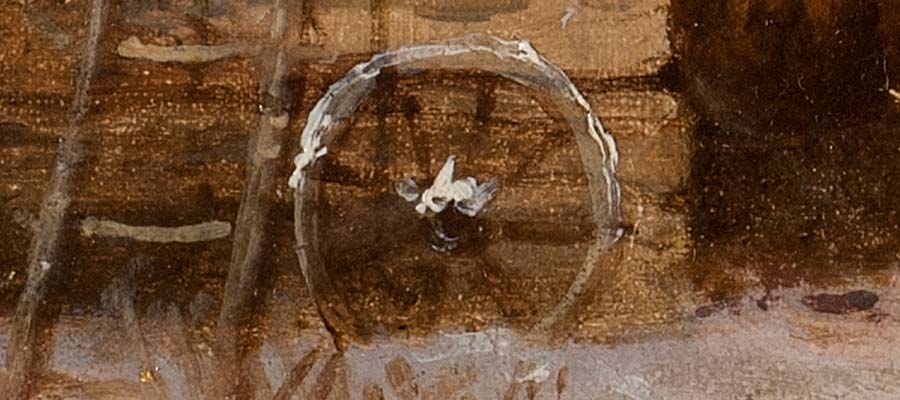
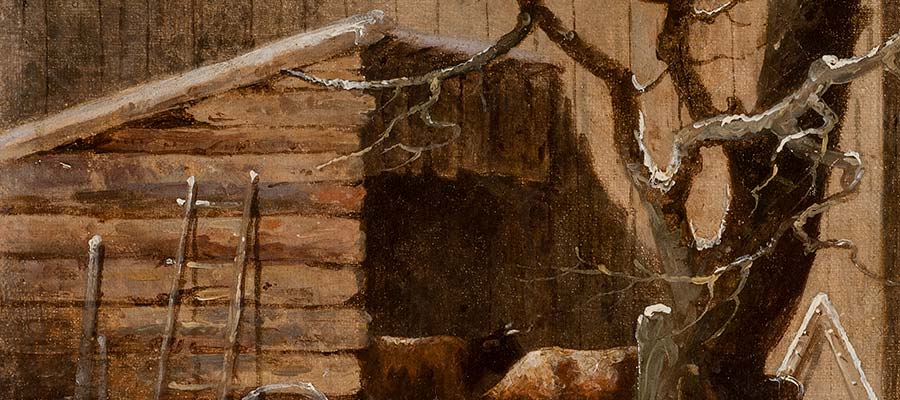
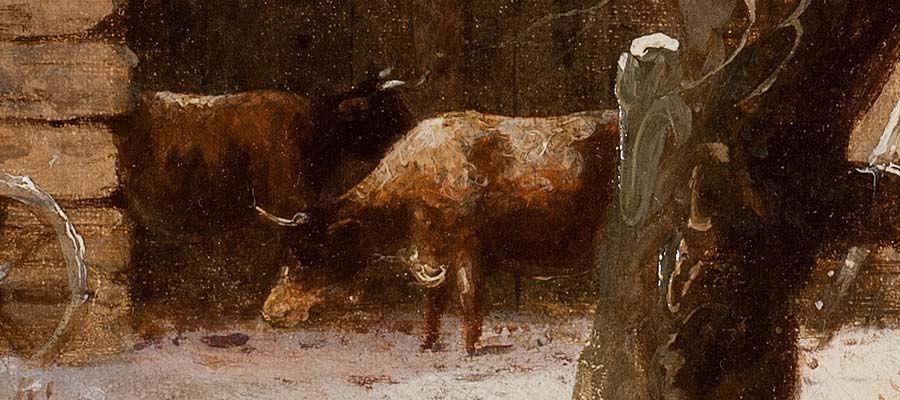

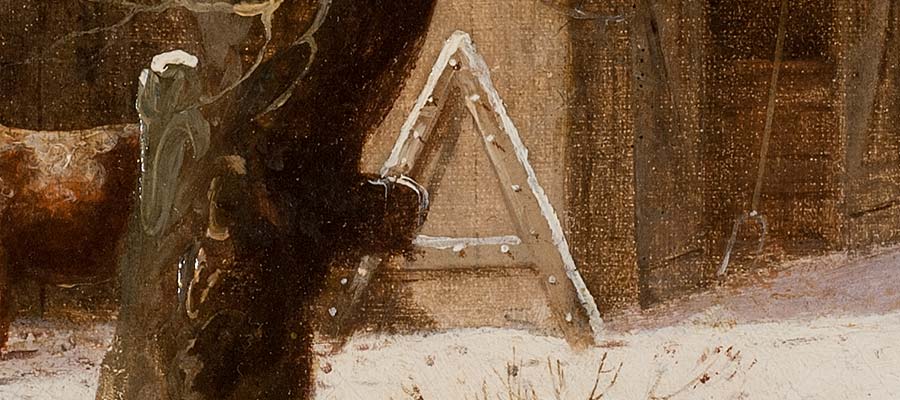

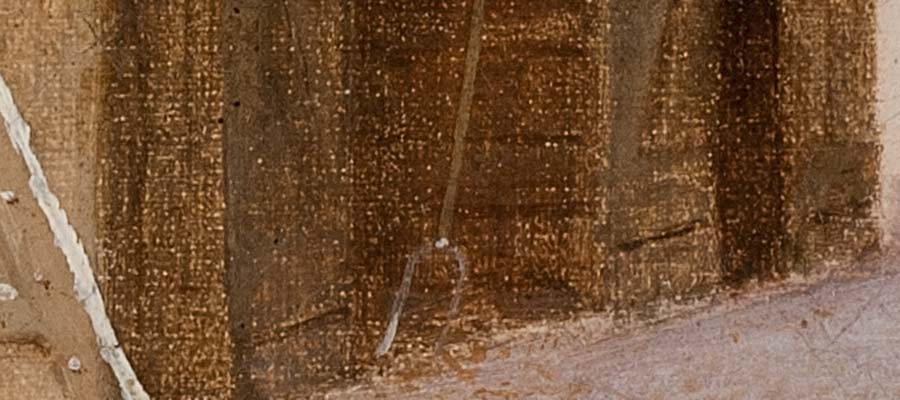
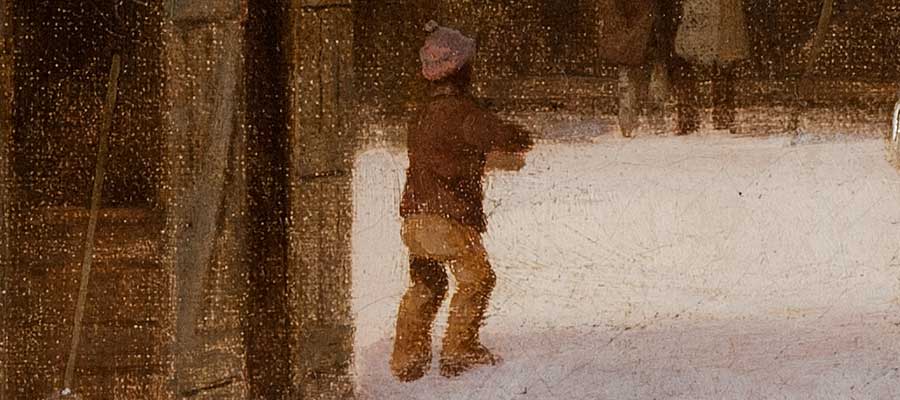
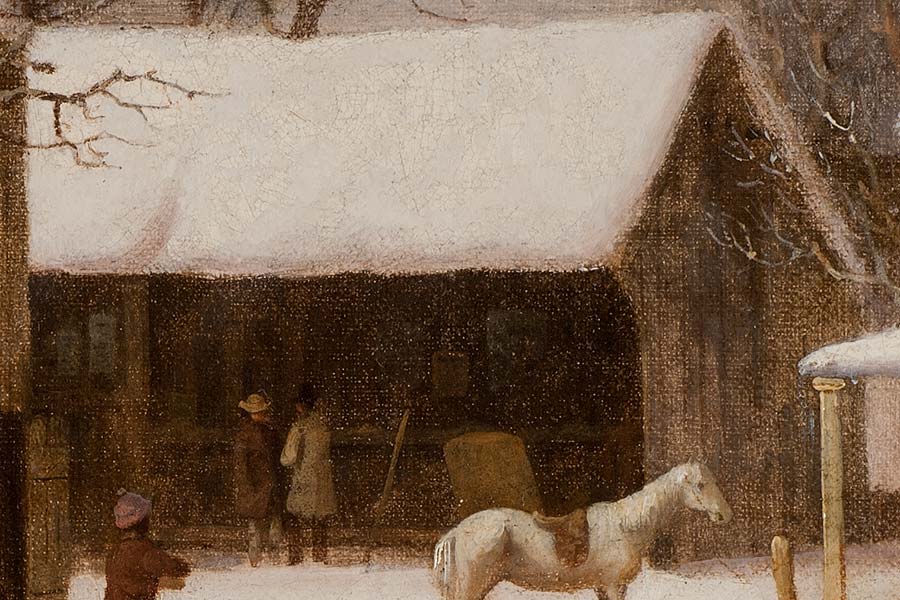

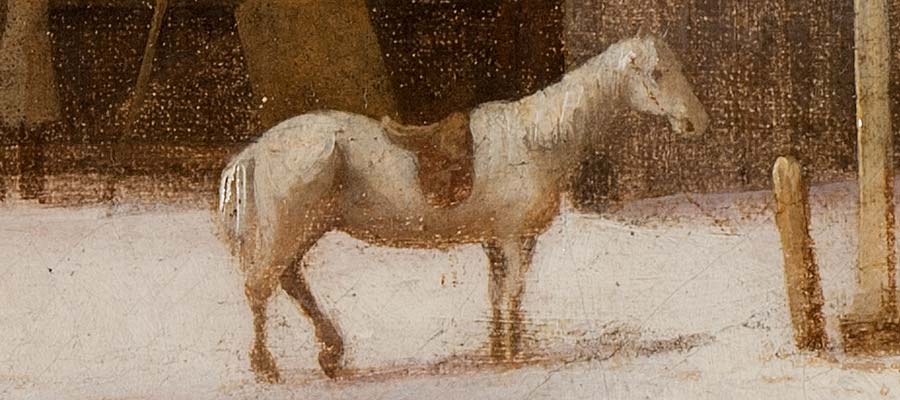

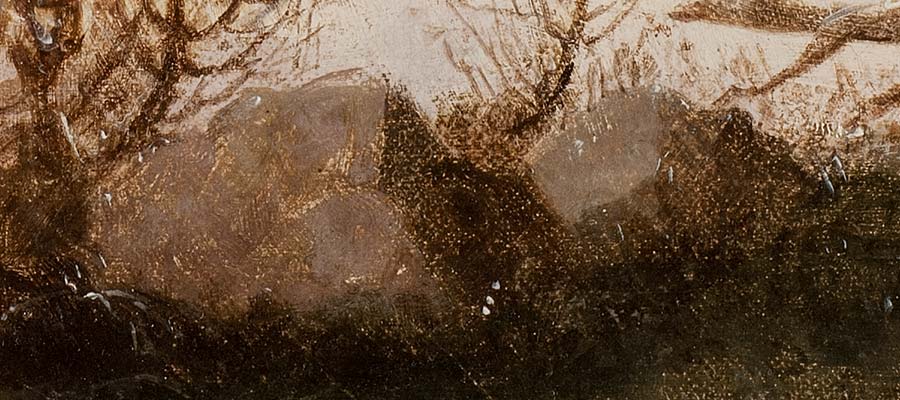





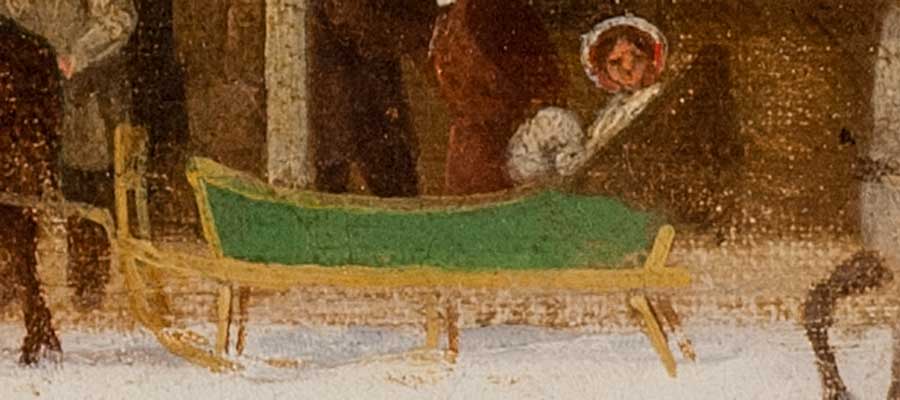
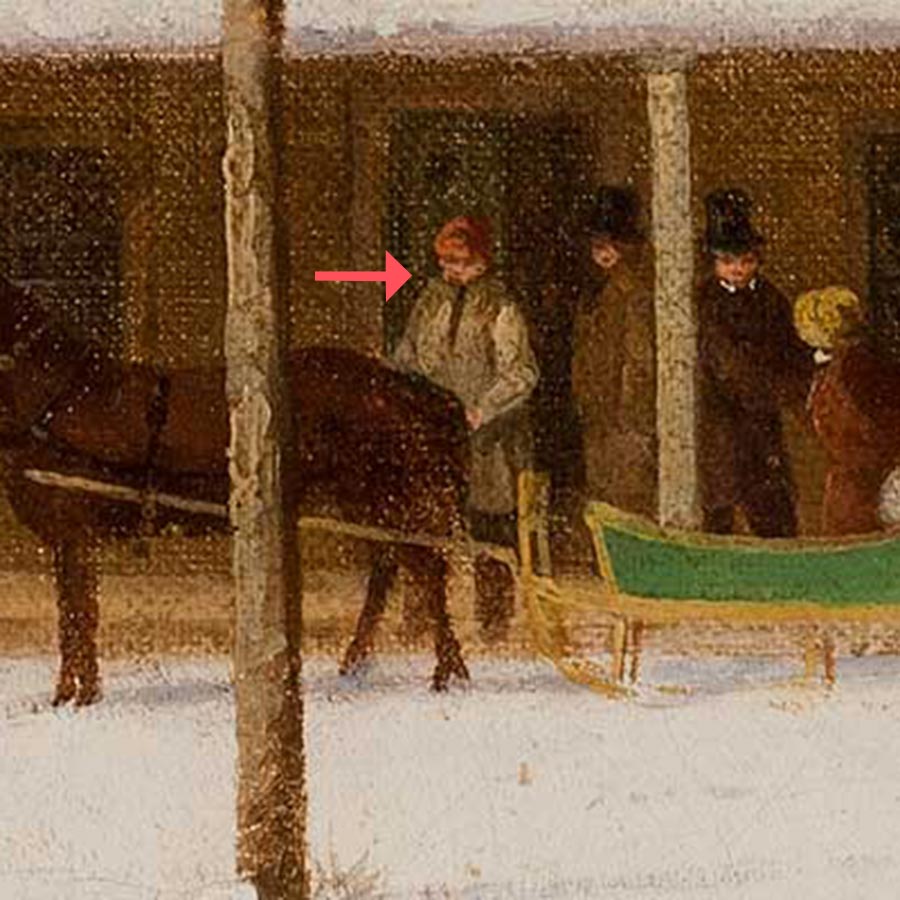
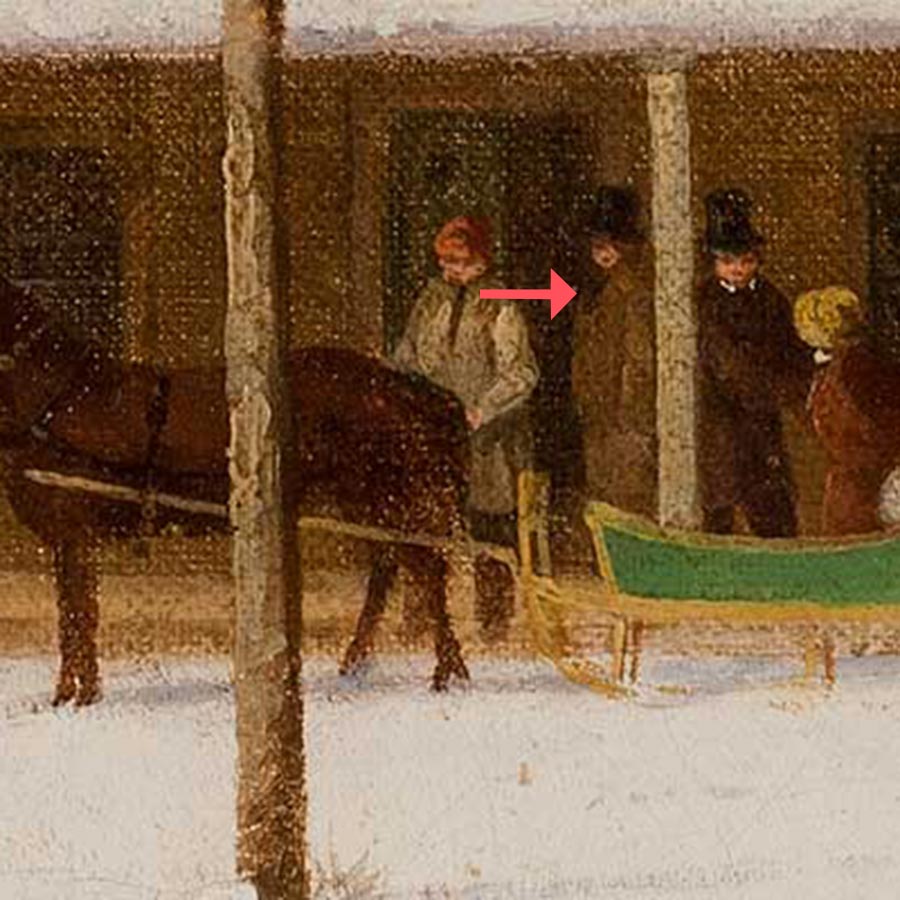
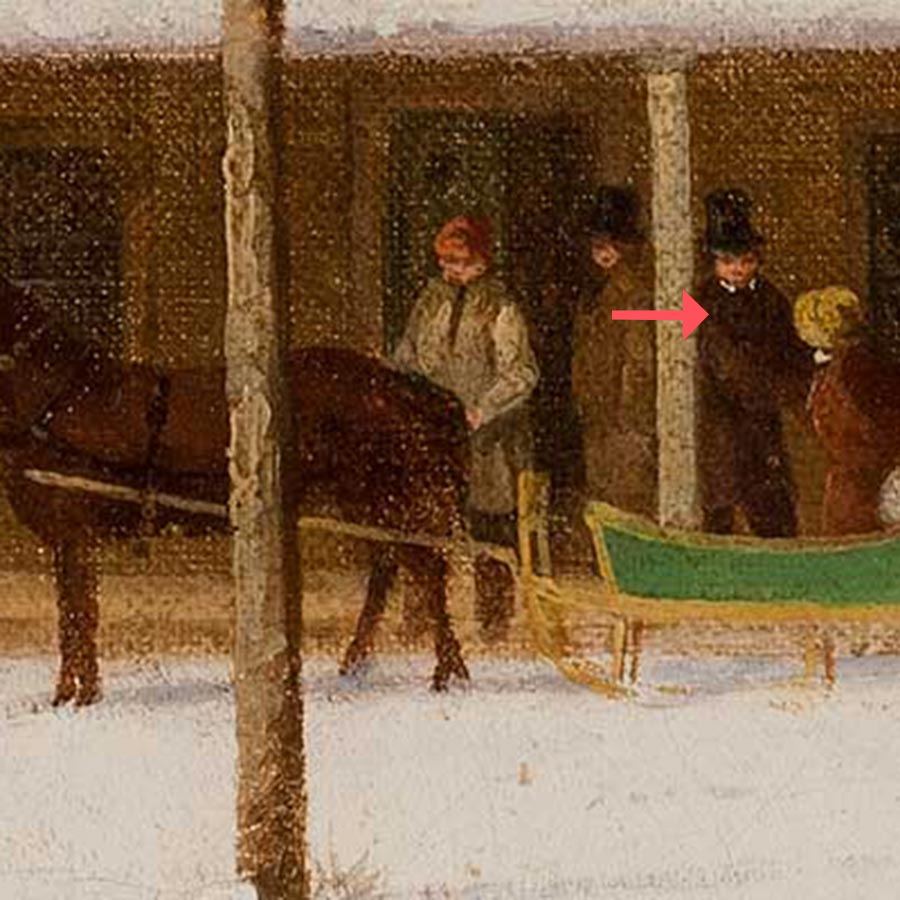
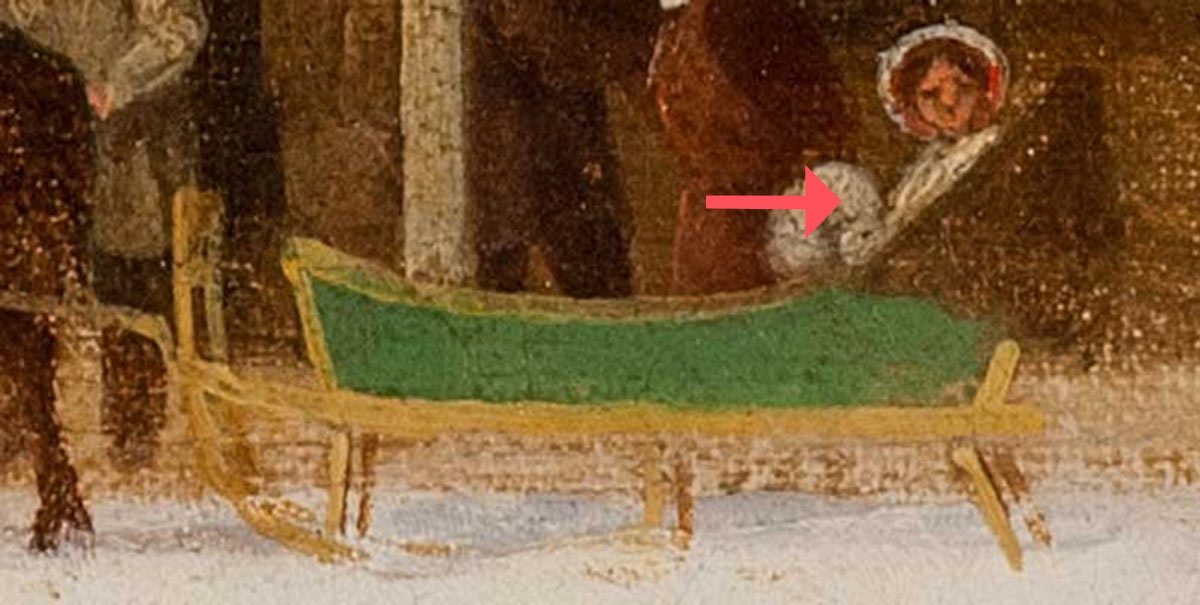

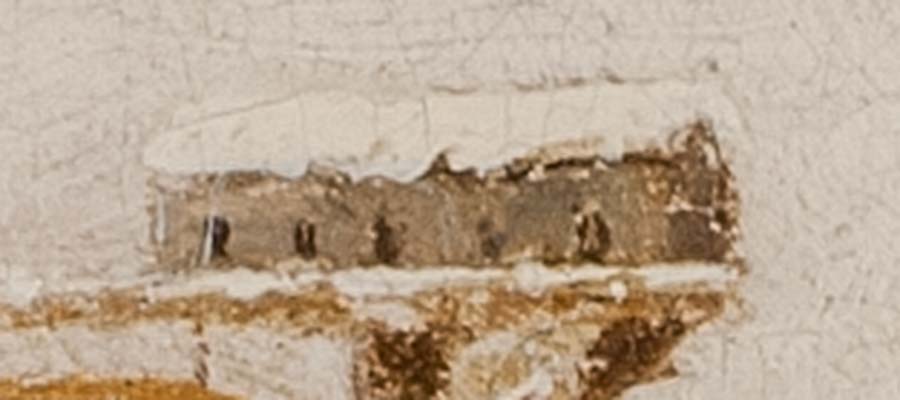
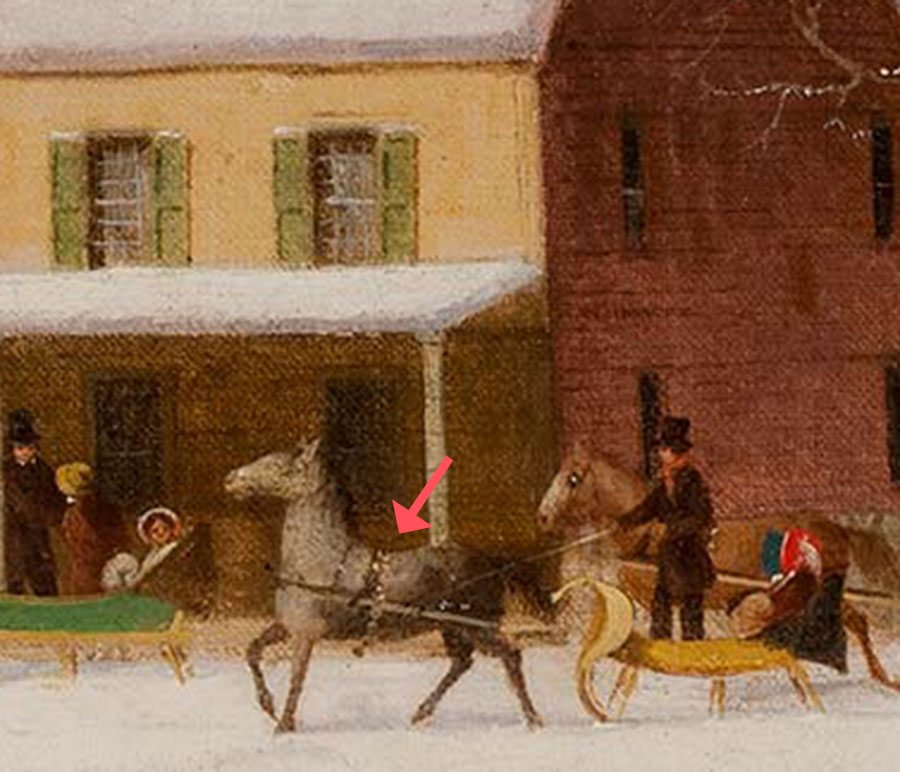
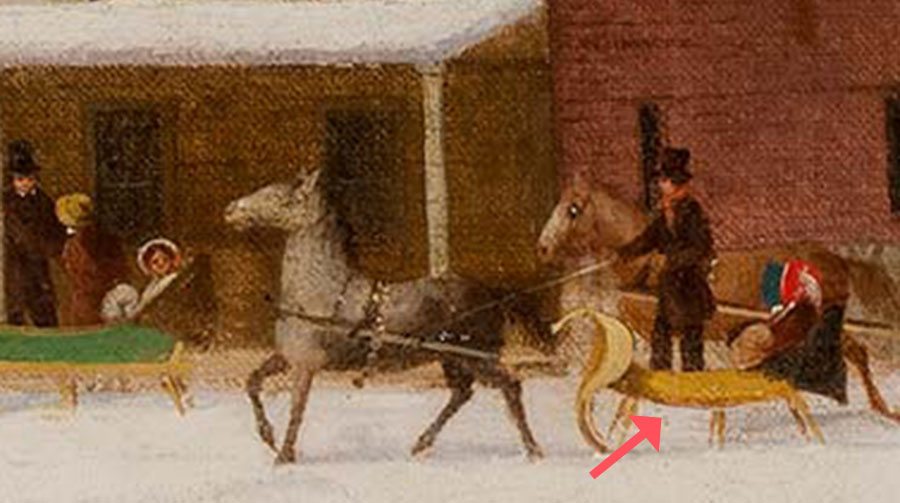


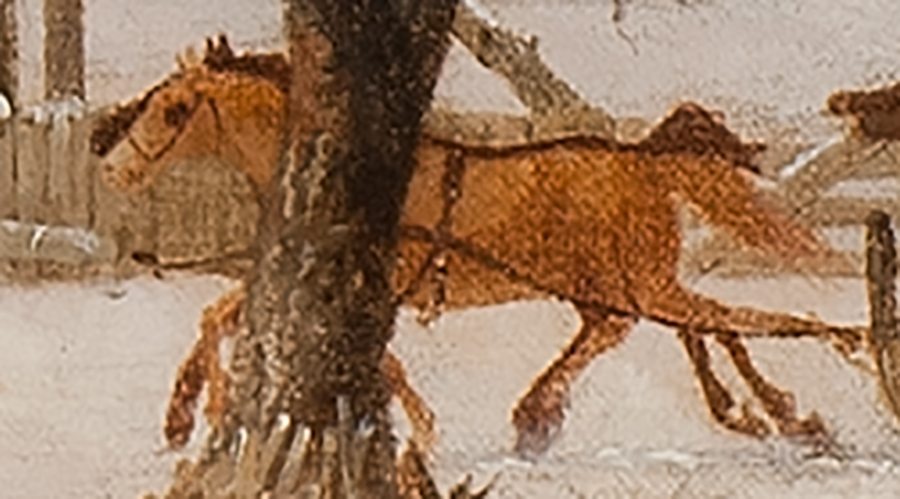
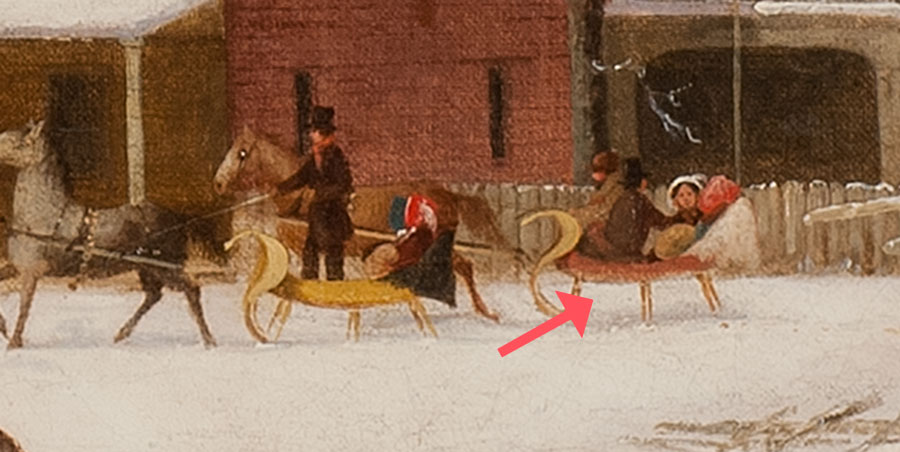
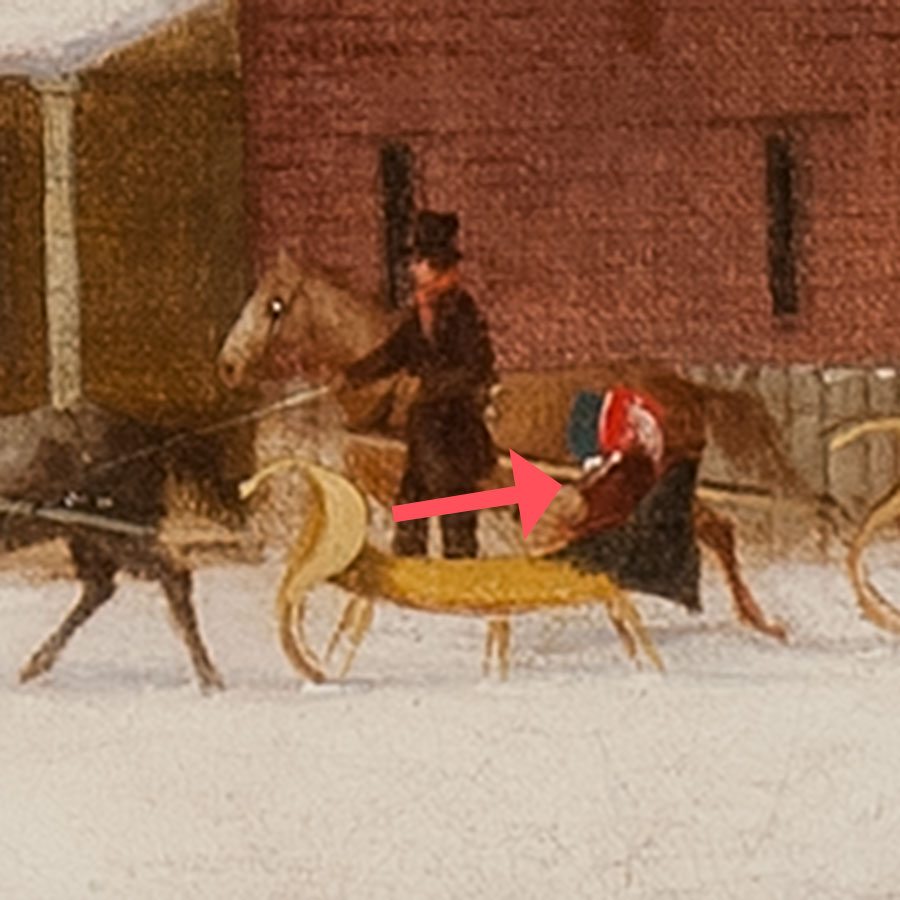

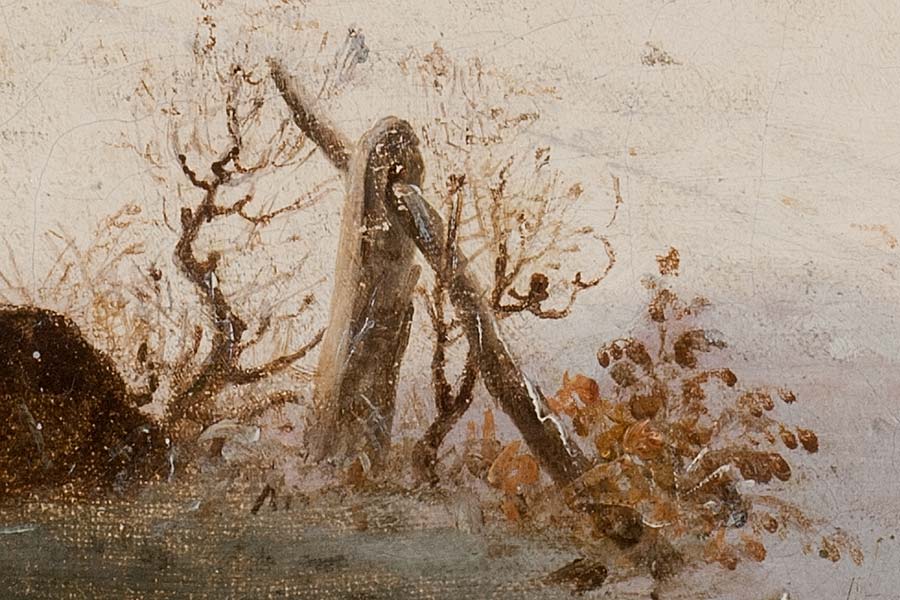
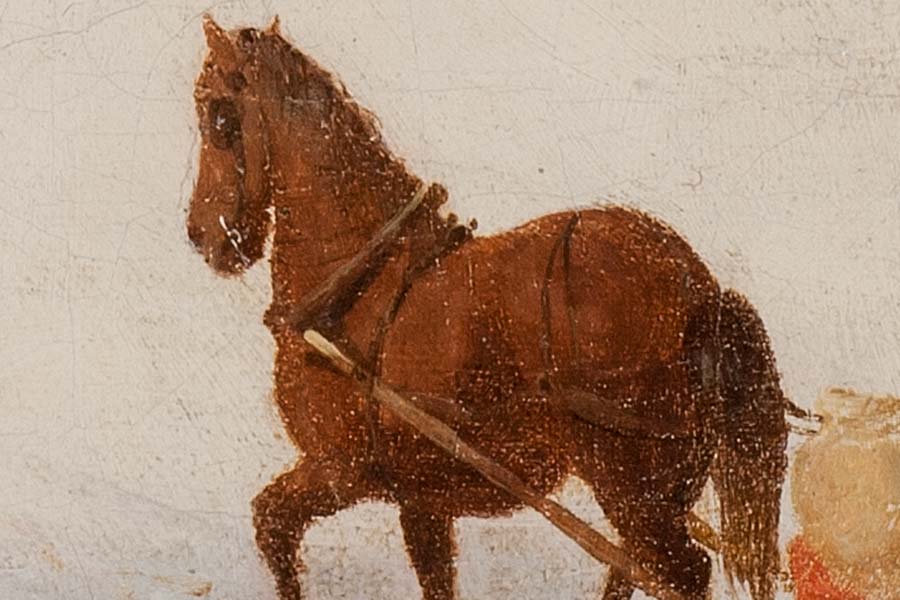
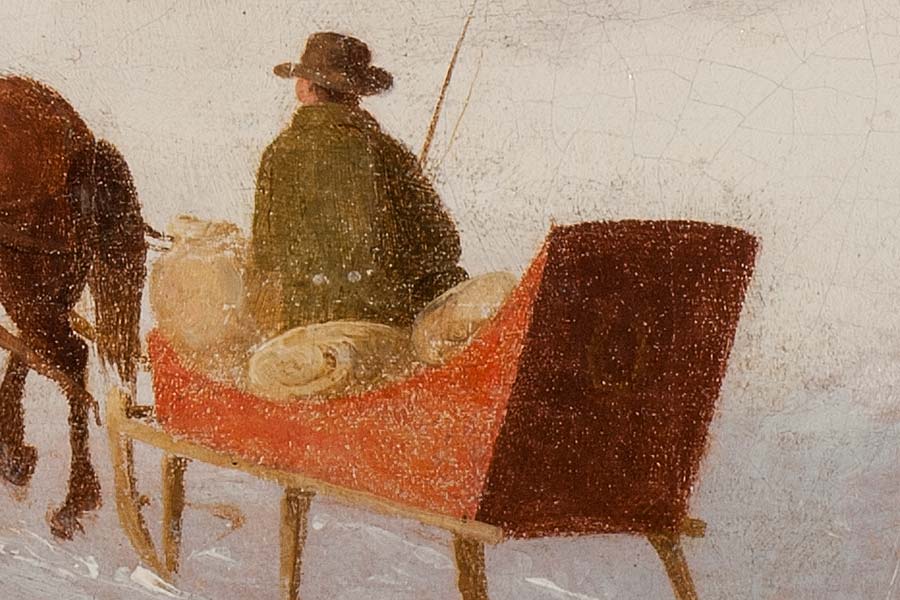

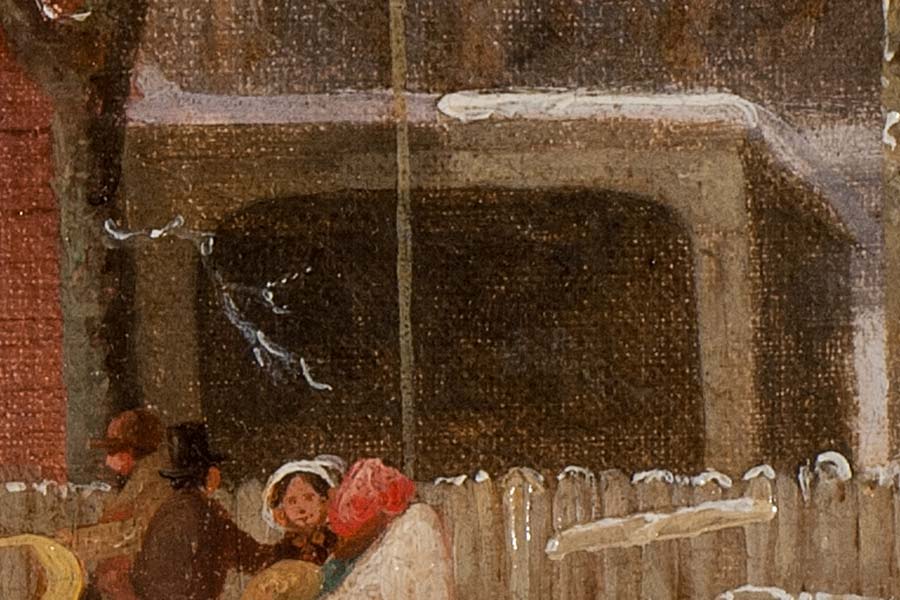
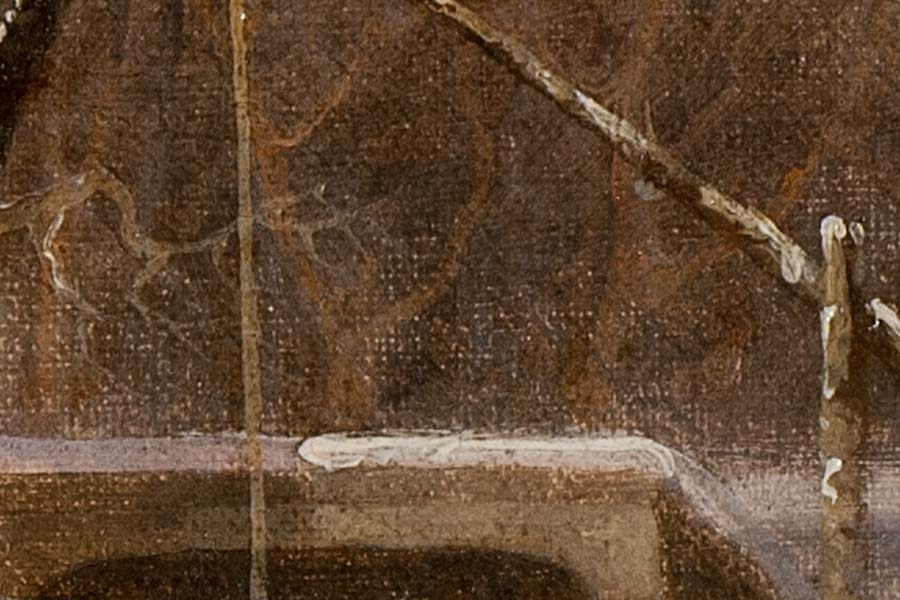


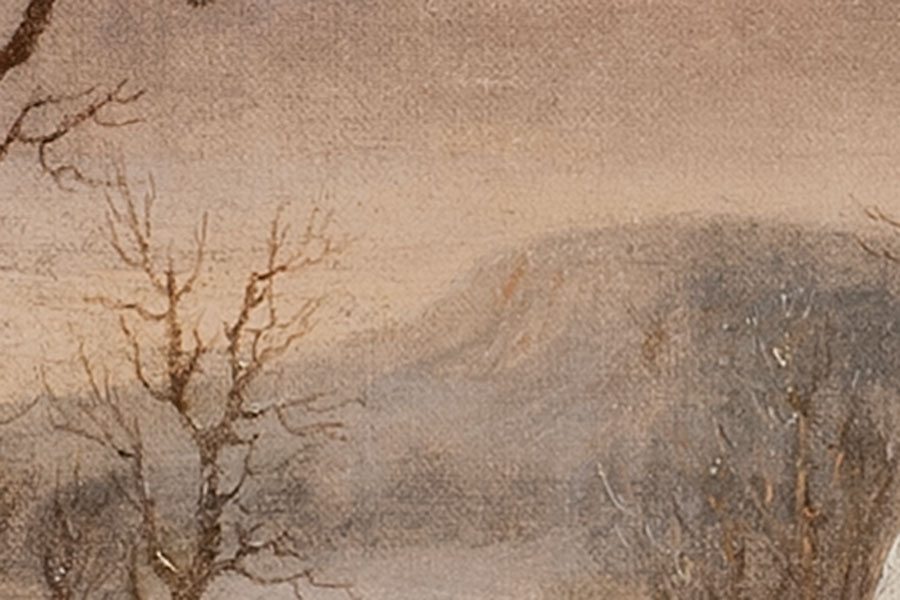

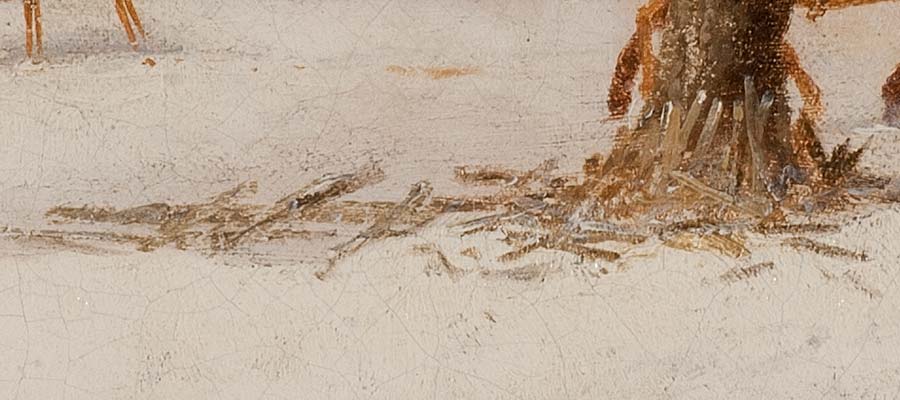

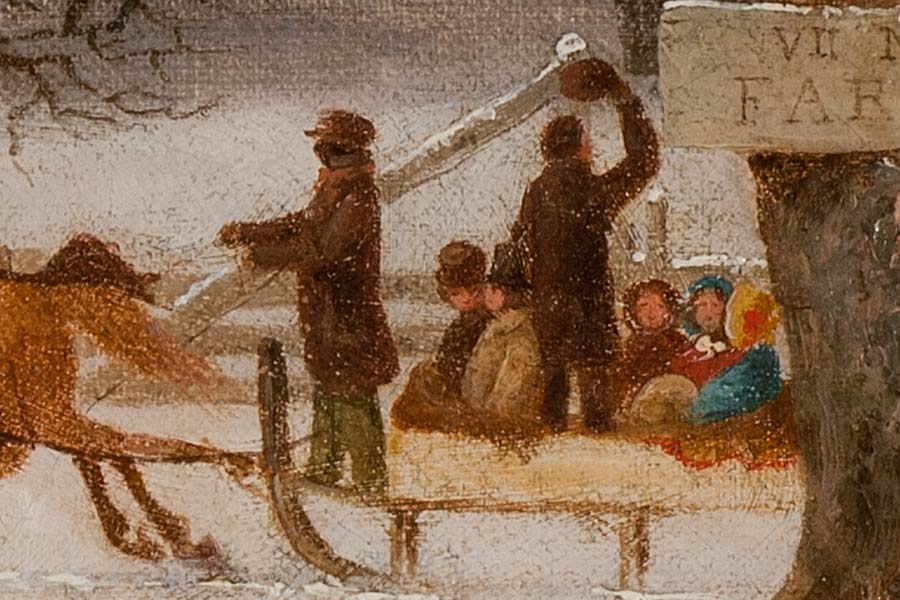
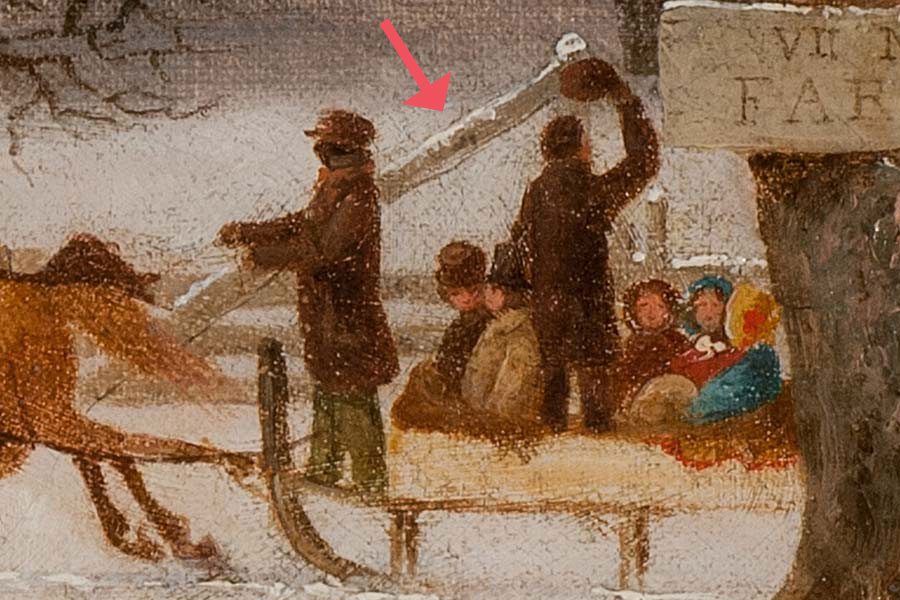

Have a question or comment regarding SEE/change? Enter your email and comment here.
"*" indicates required fields